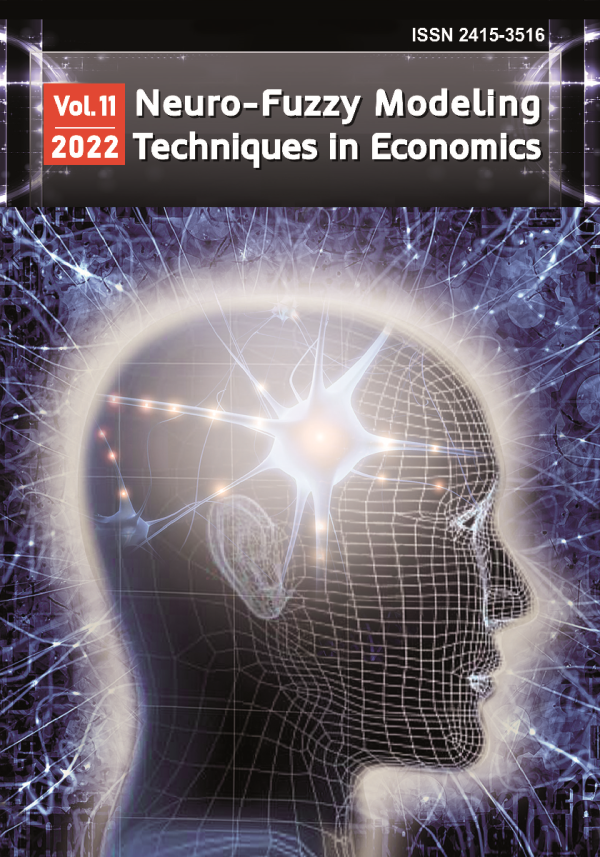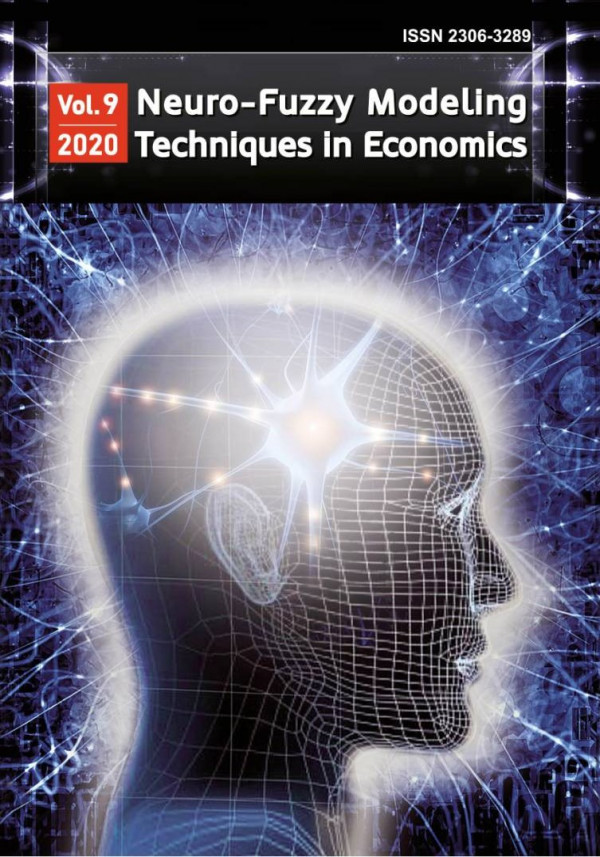
Neuro-Fuzzy Modeling Techniques in Economics
ISSN 2415-3516
Нейро-нечітке моделювання мовно-комунікативної професійної компетентності студентів економічних спеціальностей
Neuro-fuzzy modelling of economic specialties students’ speech-communicative professional competence
DOI:
10.33111/nfmte.2020.003
Анотація: У статті запропоновано новий методологічний підхід та відповідний математичний апарат на основі методів нейронних мереж та нечіткої логіки для оцінювання рівня мовно-комунікативної професійної компетентності студента. Вперше запропоновано математичну модель для оцінки рівня мовно-комунікативної професійної компетентності студентів економічних спеціальностей та метод її формалізації на основі математичного апарату нечіткої логіки та нейронної мережі Хопфілда. Це дозволяє точно й адекватно з меншими втратами часу відобразити набір вхідних параметрів до набору результуючих рішень, беручи до уваги широкий діапазон як кількісних, так і якісних факторів впливу для врахування складності та динамічності такого процесу. Для проведення розрахунків такої слабоформалізованої характеристики, як мовно-комунікативна професійна компетентність, автори статті пропонують використовувати агрегуючі функції, які дозволяють оцінити рівні: психофізичних якостей студента; особистісні якості; мовну компетентність студента економічних спеціальностей; мовленнєву компетентність; уміння забезпечити якість мовлення студента; уміння підвищувати ефективність комунікативного процесу мовлення студента. Проведені розрахунки продемонстрували валідність та ефективність запропонованого підходу та розробленого комплексу моделей для розв’язання задач із багатьма суб’єктивними змінними в умовах суттєвоїневизначеності.
Abstract: In the article, the new methodological approach and the corresponding mathematical apparatus based on neural networks and fuzzy logic methods for assessing the student’s speech-communicative professional competence level are proposed. It was proposed for the first time: the mathematical model for estimating the level of speech-communicative professional competence of economic specialties students and its formalization method based on the mathematical apparatus of fuzzy logic and the Hopfield neural network. It allows precisely and adequately with less losing time to map the set of input parameters to the set of resulting solutions, taking into account the wide range of both quantitative and qualitative factors of influence consider the complexity and dynamism of such a process. To carry out calculations of such a weakly formalized characteristic as speechcommunicative professional competence, the authors of the article propose the use of aggregation functions which allow assessing the levels of: psychophysical qualities of the student; personal qualities of the student; language competence of the economic specialties student; student’s speech competence; ability to ensure the quality of the student’s speech; skills to increase the effectiveness of the communicative process of student’s speech.
The calculations performed have demonstrated the applicability and effectiveness of the proposed approach and the developed complex of models for solving problems with many subjective variables and significant uncertainty.
Ключові слова: математична модель у лінгвістиці, мовнокомунікативна компетентність, нечітко-логічне моделювання, нейронне моделювання, нейронна мережа Хопфілда
Key words: mathematical model in linguistics, speech-communicative competence, fuzzy-logic modeling, neural modeling, Hopfield neural network
УДК: 519.8.816
UDC: 519.8.816
JEL: C02 C45 I23
To cite paper
In APA style
Azarova, A., Radomska, L., & Azarova, L. (2020). Neuro-fuzzy modelling of economic specialties students’ speech-communicative professional competence. Neuro-Fuzzy Modeling Techniques in Economics, 9, 3-25. http://doi.org/10.33111/nfmte.2020.003
In MON style
Азарова А., Радомська Л., Азарова Л. Нейро-нечітке моделювання мовно-комунікативної професійної компетентності студентів економічних спеціальностей. Нейро-нечіткі технології моделювання в економіці. 2020. № 9. С. 3-25. http://doi.org/10.33111/nfmte.2020.003 (дата звернення: 27.12.2025).
With transliteration
Azarova, A., Radomska, L., Azarova, L. (2020) Neiro-nechitke modeliuvannia movno-komunikatyvnoi profesiinoi kompetentnosti studentiv ekonomichnykh spetsialnostei [Neuro-fuzzy modelling of economic specialties students’ speech-communicative professional competence]. Neuro-Fuzzy Modeling Techniques in Economics, no. 9. pp. 3-25. http://doi.org/10.33111/nfmte.2020.003 (accessed 27 Dec 2025).
 # 9 / 2020
# 9 / 2020
Download Paper

616
Views
227
Downloads
1
Cited by
- Klymova, K. Ya. (2012). Formuvannia movnokomunikatyvnoi profesiinoi kompetentnosti studenta yak kreatyvnoi osobystosti v umovakh navchalnoho seredovyshcha pedahohichnoho vuzu [The formation of language communicative professional competence among the students, as creative individuals, in terms of educational environment at higher pedagogical educational establishments]. Naukovi zapyski Ternopilskoho natsionalnoho pedahohichnoho universytetu imeni Volodymyra Hnatiuka. Seriya: Pedahohika (The Scientific Issues of Ternopil Volodymyr Hnatiuk National Pedagogical University. Series: Pedagogy), 1, 66–72. http://nbuv.gov.ua/UJRN/NZTNPU_ped_2012_1_13 [in Ukrainian]
- Symonenko, T. V. (2017). Formuvannia rytorychnoi kompetentnosti osobystosti maibutnoho fakhivtsia v umovakh suchasnoi osvitnoi paradyhmy [Formation of the rhetorical competence of the personality of a future specialist under the contemporary educational paradigm]. Visnyk Cherkaskoho natsionalnoho universytetu imeni Bohdana Khmelnytskoho. Seriia: Pedahohichni nauky (Bulletin of the Cherkasy Bohdan Khmelnytsky National University. Series: Pedagogical Sciences), 13–14, 130–137. https://ped-ejournal.cdu.edu.ua/article/view/2259 [in Ukrainian]
- Shcherbakova, I.A., & Ilina, M.S. (2019). Foreign Language Communicative Competence Formation of University Students by Using Interactive Teaching Methods. The New Educational Review, 57, 173–183. https://doi.org/10.15804/tner.19.57.3.14
- Evtyugina, A., Zhuminova, A., Grishina, E., Kondyurina, I., & Sturikova, M. (2020). Cognitive-Conceptual Model for Developing Foreign Language Communicative Competence in Non-Linguistic University Students. International Journal of Cognitive Research in Science, Engineering and Education, 8(Special issue), 69-77. https://doi.org/10.23947/2334-8496-2020-8-SI-69-77
- Sergeeva, M.G., Sirotova, A.A., Kolchina, V.V., Kulakova, N.N., & Luchina, E.V. (2019). Content and language integrated competence of students at non-linguistic universities. Journal of Advanced Pharmacy Education and Research, 9(2), 143–148. https://japer.in/en/article/content-and-language-integrated-competence-of-students-at-non-linguistic-universities
- Nikolyuk, T., & Shklyaeva, N. (2014). Formuvannia movnokomunikatyvnoi kompetentsii v studentiv vyshchykh navchalnykh zakladiv na zaniattiakh iz ukrainskoi movy (za profesiinym spriamuvanniam) [Formation of speech and communicative competence of higher educational institution’s students in Ukrainian language classes (by professional focus)]. Naukovyi chasopys Natsionalnoho pedahohichnoho universytetu imeni M. P. Drahomanova. Seriya 8: Filolohichni nauky (movoznavstvo) (Scientific journal of National Pedagogical Dragomanov University. Series 8: Philological Sciences (Linguistics)), 6, 156-160. http://enpuir.npu.edu.ua/bitstream/handle/123456789/15816/Nykolyuk_Shklyayeva.pdf?sequence=1&isAllowed=y [in Ukrainian]
- Azarova, A. O., Azarova, L. E., Pavlov, S. V., Savina, N. B., Kaplun, I. S., Wójcik, W., Smailova, S., & Kalizhanova, A. (2020). Information technologies for assessing the quality of IT-specialties graduates’ training of university by means of fuzzy logic and neural networks. International Journal of Electronics and Telecommunications, 66(3), 411-416. https://doi.org/10.24425/ijet.2020.131893
- Azarova, A., & Antoniuk, O. (2012). Systema otsiniuvannia rivnia vykorystannia stratehichnoho potentsialu pidpryiemstva ta pryiniattia rishen shchodo yoho pidvyshchennia [The system of evaluation of level of enterprise strategic potential and making decisions for its improving]. Neiro-Nechitki Tekhnolohii Modelyuvannya v Ekonomitsi (Neuro-Fuzzy Modeling Techniques in Economics), 1, 37-64. https://doi.org/10.33111/nfmte.2012.037 [in Ukrainian]
- Lopatynska, N. A. (2015). Movna, movlennieva ta komunikatyvna kompetentsii u studentiv vyshchykh navchalnykh zakladiv yak skladnyky fakhovoi kultury maibutnoho korektsiinoho pedahoha [Linguistic and communicative competence in university students as a component of future correction teacher]. Aktualni pytannia korektsiynoi osvity (Actual problems of the correctional education), 5, 187−197. https://aqce.com.ua/download/publications/203/239.pdf [in Ukrainian]
- Aggarwal, C. (2018). Neural Networks and Deep Learning. Springer. https://doi.org/10.1007/978-3-319-94463-0
- Taylan, O., & Karagözoğlu, B. (2009). An adaptive neuro-fuzzy model for prediction of student’s academic performance. Computers & Industrial Engineering, 57(3), 732-741. https://doi.org/10.1016/j.cie.2009.01.019
- Son, L. H., & Fujita, H. (2019). Neural-fuzzy with representative sets for prediction of student performance. Applied Intelligence, 49, 172-187. https://doi.org/10.1007/s10489-018-1262-7
- Luaces, O., Diez, J., Alonso-Betanzos, A., Troncoso, A., & Bahamonde, A. (2017). Content-based methods in peer assessment of open-response questions to grade students as authors and as graders. Knowledge-Based Systems, 117, 79–87. https://doi.org/10.1016/j.knosys.2016.06.024
- Rusli, N. M., Ibrahim, Z., & Janor, R. M. (2008). Predicting students’ academic achievement: Comparison between logistic regression, artificial neural network, and Neuro-fuzzy. In Proceedings of 2008 International Symposium on Information Technology: Vol. 1 (pp. 1-6). IEEE. https://doi.org/10.1109/ITSIM.2008.4631535
- Anderson, J. L. (2006). Predicting Final GPA of Graduate School Students: Comparing Artificial Neural Networking and Simultaneous Multiple Regression. College and University, 81(4), 19-29. https://eric.ed.gov/?id=EJ745905
- Arora, N., & Saini, J. R. (2013). A fuzzy probabilistic neural network for student’s academic performance prediction. International Journal of Innovative Research in Science, Engineering and Technology, 2(9), 4425-4432. http://www.ijirset.com/upload/september/31_A%20Fuzzy.pdf
- Ayyanathan, N., Kannammal, A., & Rekha, A.B. (2012). Students’ Communicative Competence Prediction and Performance Analysis of Probabilistic Neural Network Model. International Journal of Computer Science Issues, 9(4 (2), 312–317. https://www.academia.edu/3834064/Students_Communicative_Competence_Prediction_and_Performance_Analysis_of_Probabilistic_Neural_Network_ModelReference_for_Language_Teaching_and_Assessment_CEFR_Regression_Statistics_Probabilistic_Neural_Network_PNN_Learning_Management_System
- Yasin, K., Aziz, Z.A., & Jannah, R. (2017). Communicative Language Teaching (CLT) for Teaching Speaking. English Education Journal, 8(3), 322–337. https://jurnal.usk.ac.id/EEJ/article/view/8921/7069
- Hopfield, J. J. (1982). Neural networks and physical systems with emergent collective computational abilities. Proceedings of the National Academy of Sciences of the United States of America, 79(8), 2554–2558. https://doi.org/10.1073/pnas.79.8.2554
- Haykin, S. (2013). Adaptive Filter Theory (5th ed.). Pearson.

